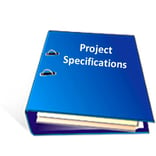Remember the scene in the rock music mockumentary, “This Is Spinal Tap,” where the Stonehenge model built for the concert stage as a prop turned out to be 18 inches high instead of the intended 18 feet (thus turning the group into a laughingstock)? It was traced back to a bad spec written on a napkin.
Don’t let this sort of major mistake happen to you when you’re writing specs for a printer.
 In our short series about print buying, we’re focusing on the basics. One of these basics is supplying your commercial printer with job specs. You shouldn’t try and jot down job details when you’re in a hurry. (Keep the Stonehenge fiasco in your mind.)
In our short series about print buying, we’re focusing on the basics. One of these basics is supplying your commercial printer with job specs. You shouldn’t try and jot down job details when you’re in a hurry. (Keep the Stonehenge fiasco in your mind.)
Every print job is customized and based on the specifications you give to the printer. Lots of printers have a spec form on their web sites to automate this task. They’re not perfect, but such forms are usually better than constructing specs all on your own.
Here’s a list of the 12 basic specs every printer needs to know about your job.
1. Job name and description
This is for easy reference. Always make sure the contact person’s name, email, phone, etc., is provided.
2. Delivery date requested
The date you need it is key. You need to be sure a printer can deliver when you need it.
3. Quantity
How many do you need? If this job is tied to a mailing list, be careful about the final quantity. You don’t want to run short. Extras (“overs”) are standard on any print job, BTW.
4. Flat size
What size is the piece before it’s finished or folded? Dimensions are given by width and then by height (think 8 1/2 x 11).
5. Finished size
These note the dimensions once a job is folded or bound.
6. Page count
This applies to magazines, bound newsletters, books, booklets, and some brochures.
7 . Paper stock
This is a big one, as paper is the major cost of almost every print job. If you have a specific stock in mind, give the printer all of the details. If not, describe the paper in general and ask for help.
8. Inks
Is this a 1-color, 2-color, or 4-color job, for example? Tell your printer everything. If it’s a 4-color job, are you requesting CMYK (the 4 process colors) or specific PMS colors? If your finished job will be run through laser printers, make sure you note this on the spec form. The inks must be compatible.
9. Binding
This describes any finishing steps done to a job once it’s printed, including folding, perfect binding, spiral binding, saddlewiring, perforating, scoring, embossing, and so on.
10. Job format
How will the printer get your job file – electronically? If so, what platform are you using (Mac or PC)? How about the design programs you’re using to build the job, including the specific versions
11. Special concerns
Tell the printer anything about the job that you haven’t already. Does it need certain varnishes? Is it a VDP job? Are there going to be a significant amount of solids on it? Will this piece need to match other projects that are already printed (or are printing elsewhere)?
12. Shipping
Where will the finished job be shipped? Supply all details, including any special shipping or packing instructions.
Keep this list handy as you supply job specs to your printers. Remember to give every printer who’s bidding on your job the same set of specs. And remember this: once you’ve awarded a job and it’s in production, specs often change, even just a little bit. Find out from your printer what this might do to your quoted price.
Finally, the smartest thing to do when spec’ing a job for a printer is to ask your printer for his or her own ideas as well. Chances are good that a printer will come up with suggestions to improve your job. You want your printer’s input to help make every job a raging success.
This post is the third in a series of what a print buyer does. If you missed the first two, catch them here: Congrats, you're a print buyer! Now what? and What the Heck Does a Print Buyer Do?

